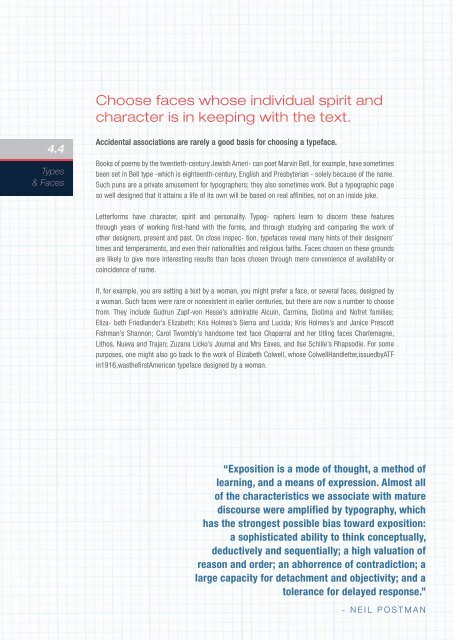5 Trick Pony Brand Guidelines v3
Create successful ePaper yourself
Turn your PDF publications into a flip-book with our unique Google optimized e-Paper software.
Choose faces whose individual spirit and<br />
character is in keeping with the text.<br />
4.4<br />
Types<br />
& Faces<br />
Accidental associations are rarely a good basis for choosing a typeface.<br />
Books of poems by the twentieth-century Jewish Ameri- can poet Marvin Bell, for example, have sometimes<br />
been set in Bell type -which is eighteenth-century, English and Presbyterian - solely because of the name.<br />
Such puns are a private amusement for typographers; they also sometimes work. But a typographic page<br />
so well designed that it attains a life of its own will be based on real affinities, not on an inside joke.<br />
Letterforms have character, spirit and personality. Typog- raphers learn to discern these features<br />
through years of working first-hand with the forms, and through studying and comparing the work of<br />
other designers, present and past. On close inspec- tion, typefaces reveal many hints of their designers’<br />
times and temperaments, and even their nationalities and religious faiths. Faces chosen on these grounds<br />
are likely to give more interesting results than faces chosen through mere convenience of availability or<br />
coincidence of name.<br />
If, for example, you are setting a text by a woman, you might prefer a face, or several faces, designed by<br />
a woman. Such faces were rare or nonexistent in earlier centuries, but there are now a number to choose<br />
from. They include Gudrun Zapf-von Hesse’s admirable Alcuin, Carmina, Diotima and Nofret families;<br />
Eliza- beth Friedlander’s Elizabeth; Kris Holmes’s Sierra and Lucida; Kris Holmes’s and Janice Prescott<br />
Fishman’s Shannon; Carol Twombly’s handsome text face Chaparral and her titling faces Charlemagne,<br />
Lithos, Nueva and Trajan; Zuzana Licko’s Journal and Mrs Eaves, and Ilse Schiile’s Rhapsodie. For some<br />
purposes, one might also go back to the work of Elizabeth Colwell, whose ColwellHandletter,issuedbyATF<br />
in1916,wasthefirstAmerican typeface designed by a woman.<br />
“Exposition is a mode of thought, a method of<br />
learning, and a means of expression. Almost all<br />
of the characteristics we associate with mature<br />
discourse were amplified by typography, which<br />
has the strongest possible bias toward exposition:<br />
a sophisticated ability to think conceptually,<br />
deductively and sequentially; a high valuation of<br />
reason and order; an abhorrence of contradiction; a<br />
large capacity for detachment and objectivity; and a<br />
tolerance for delayed response.”<br />
- NEIL POSTMAN





